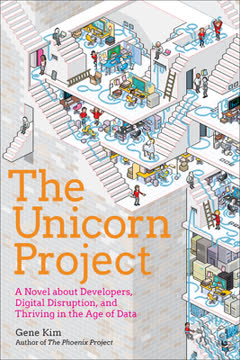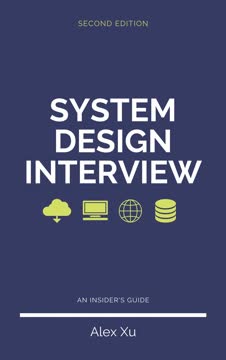Key Takeaways
1. Architect for the Business, Not Your Resume
Always put the customer's long-term needs ahead of your own short-term needs and you won't go wrong.
Prioritize business value. As an architect, your primary responsibility is to create solutions that address the organization's needs, not to pad your resume with the latest technologies. Focus on delivering systems that solve real business problems and provide tangible benefits. This may mean choosing simpler, proven technologies over cutting-edge options that don't align with the project's goals.
Avoid overengineering. Resist the temptation to implement complex solutions for simple problems. Overengineering can lead to increased development time, higher costs, and more difficult maintenance. Instead, strive for elegant simplicity that meets the current requirements while allowing for future scalability.
- Choose technologies based on project needs, not personal preferences
- Regularly validate architectural decisions against business objectives
- Be prepared to justify technical choices in terms of business value
2. Simplify Complexity and Embrace Change
Essential complexity represents the difficulty inherent in any problem.
Distinguish essential complexity. In every project, there's inherent complexity that cannot be avoided. Your job as an architect is to identify this essential complexity and find ways to manage it effectively. At the same time, work to eliminate or reduce accidental complexity – the unnecessary complications that arise from poor design choices or overengineering.
Design for change. Recognize that requirements will evolve, and technologies will advance. Create architectures that are flexible and adaptable to change. This involves designing modular systems with clear boundaries and interfaces, allowing components to be updated or replaced with minimal impact on the overall system.
- Use abstraction and encapsulation to manage complexity
- Implement loose coupling between system components
- Regularly refactor to keep the codebase clean and maintainable
- Adopt iterative development approaches to accommodate changing requirements
3. Communication is Crucial for Effective Architecture
Communication Is King; Clarity and Leadership, Its Humble Servants.
Develop strong communication skills. As an architect, your ability to communicate complex ideas clearly and persuasively is paramount. You must be able to articulate your vision to both technical and non-technical stakeholders, ensuring everyone understands the architectural decisions and their implications.
Lead through influence. Effective architects don't just dictate solutions; they build consensus and inspire teams to embrace architectural principles. Cultivate leadership skills that allow you to guide development teams, manage stakeholder expectations, and navigate organizational politics.
- Practice explaining technical concepts in simple, relatable terms
- Use visual aids like diagrams and models to illustrate architectural concepts
- Actively listen to feedback and concerns from all stakeholders
- Develop skills in negotiation and conflict resolution
4. Balance Technical Expertise with Business Understanding
Understand the Business Domain.
Gain deep domain knowledge. To create truly effective solutions, architects must have a thorough understanding of the business domain they're working in. This knowledge allows you to make informed decisions that align with business goals and anticipate future needs.
Bridge the gap between technology and business. Position yourself as a translator between technical teams and business stakeholders. Be able to explain technical concepts to non-technical audiences and translate business requirements into architectural decisions.
- Regularly engage with business stakeholders to understand their goals and challenges
- Stay informed about industry trends and competitive landscapes
- Develop a working knowledge of business processes and metrics
- Evaluate architectural decisions based on their impact on key business objectives
5. Design for Maintainability and Future Evolution
Stable Problems Get High-Quality Solutions.
Focus on long-term sustainability. While it's important to deliver solutions that meet current needs, great architects design systems that can evolve and adapt over time. Consider how your architecture will accommodate future growth, new features, and changing technologies.
Emphasize maintainability. A well-designed system should be easy to understand, modify, and extend. Prioritize clean code, clear documentation, and modular design to ensure that future developers can work effectively with your architecture.
- Implement clear separation of concerns in your design
- Create comprehensive, up-to-date documentation
- Design for testability to ensure long-term reliability
- Plan for scalability from the outset
6. Understand and Manage Technical Debt
Shortcuts Now Are Paid Back with Interest Later.
Recognize the impact of technical debt. Every decision to take a shortcut or delay proper implementation creates technical debt. While some debt may be necessary to meet short-term goals, it's crucial to understand the long-term consequences and have a plan to address it.
Actively manage debt. Create processes for identifying, tracking, and addressing technical debt. Regularly allocate time and resources to refactoring and improving existing systems, rather than solely focusing on new features.
- Educate stakeholders about the concept and impact of technical debt
- Include debt reduction as part of your project planning and estimation
- Use code quality tools and metrics to identify areas needing improvement
- Balance the need for quick delivery with long-term maintainability
7. Focus on Data and Performance from the Start
It Is All About The Data.
Prioritize data architecture. The structure and management of data are fundamental to any system's success. Invest time in designing robust data models, considering issues like data integrity, scalability, and performance from the outset.
Build performance in from the beginning. Performance should not be an afterthought. Consider performance implications in your initial design decisions, and implement monitoring and optimization strategies throughout the development process.
- Design flexible, scalable data models that can evolve with the business
- Implement proper data governance and security measures
- Use caching, indexing, and other optimization techniques proactively
- Establish performance benchmarks and regularly test against them
8. Embrace Diverse Technologies and Continuous Learning
Learn a New Language.
Stay technologically diverse. While specialization has its place, great architects have a broad understanding of various technologies and paradigms. This diversity allows you to choose the best tools for each job and integrate different systems effectively.
Commit to lifelong learning. The technology landscape is constantly evolving. Make a habit of continuous learning, exploring new technologies, methodologies, and best practices. This ongoing education will help you make informed decisions and stay relevant in your field.
- Experiment with new languages, frameworks, and tools regularly
- Attend conferences, workshops, and meetups to stay current
- Engage in side projects to gain hands-on experience with emerging technologies
- Share your knowledge through mentoring, writing, or speaking engagements
9. Build and Retain Strong Development Teams
Find and Retain Passionate Problem Solvers.
Cultivate talent. As an architect, your success depends largely on the strength of your development team. Invest time in identifying, recruiting, and nurturing talented developers who are passionate about solving complex problems.
Foster a positive team culture. Create an environment that encourages innovation, collaboration, and continuous improvement. Recognize and reward good work, provide opportunities for growth, and address conflicts constructively.
- Look for problem-solving skills and passion during the hiring process
- Provide regular feedback and opportunities for professional development
- Encourage knowledge sharing and cross-training within the team
- Create a culture that values both individual contributions and team success
10. Create Flexible, User-Centric Solutions
Build Systems to Be Zuhanden.
Design for usability. Great architecture should ultimately serve the end-users. Strive to create systems that are intuitive, efficient, and enjoyable to use. Consider user experience factors in your architectural decisions.
Embrace flexibility. Recognize that requirements will change and users' needs will evolve. Design systems that can adapt to new requirements without requiring complete overhauls.
- Involve users early and often in the design process
- Use modular, component-based architectures for easier updates
- Implement feature toggles and configuration-driven behavior
- Regularly gather and act on user feedback to improve the system
Last updated:
Review Summary
97 Things Every Software Architect Should Know receives mixed reviews. Readers appreciate its collection of short essays offering diverse perspectives on software architecture. Many find it useful for quick insights and reflections, especially for aspiring architects. However, critics note its lack of depth, repetitiveness, and scattered organization. Some praise its practical advice and philosophical approach, while others find it too general or obvious. The book's format of 97 two-page articles is both praised for accessibility and criticized for superficiality. Overall, it's seen as a decent starting point but not a comprehensive guide.
Similar Books










Download PDF
Download EPUB
.epub digital book format is ideal for reading ebooks on phones, tablets, and e-readers.




